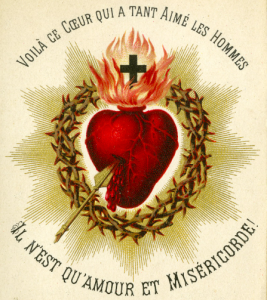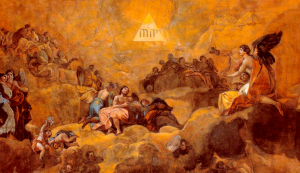Here beginneth the First Part of TRINITYTIDE

The Sacred Heart of Jesus,
from a late 19th-c. French prayer card.
15 Jun. Solemnity of the Most Holy Trinity
20. St. Alban (?-305?), Protomartyr of England, patron of refugees and torture victims
21. St. Aloysius Gonzaga (1568-1591), SJ, patron of youth and of AIDS patients
22. Solemnity of our Lord’s Body and Blood (memorial of SS. John Fisher and Thomas More suppressed)
23. SS. Audrey (c. 636-679), Hilda of Whitby (614-680), and All Holy Nuns, patronesses: (St. Audrey) of throat diseases; and (St. Hilda) of poets
24. Solemnity of the Nativity of the Baptist (c. 1 BC), traditionally held to mark midsummer
27. Solemnity of the Sacred Heart
29. Solemnity of SS. Peter (c. 4?-c. 65) and Paul (?-c. 66), Apostles and Martyrs, patrons: (St. Peter) of fishermen, shipwrights, locksmiths, and against fever; and (St. Paul) of missionaries, theologians, and Gentile Christians
Here endeth the First, and beginneth the Second Part of TRINITYTIDE

Adoration of the Name of God, Francisco Goya.
30. Protomartyrs of the Church of Rome (c. 65-68)
3 Jul. St. Thomas the Apostle (?-72?)
4. Independence Day [US] (1776)
5. St. Elizabeth of Portugal (1271-1336), patroness of peacemakers
6. Third Sunday after Trinity (memorial of St. Maria Goretti suppressed)
9. Our Lady of the Atonement
11. St. Benedict (480-547), Priest, founder of the Benedictines, patron of Europe
13. Fourth Sunday after Trinity
14. St. Kateri Tekakwitha (1656-1680), Virgin, “the lily of the Mohawks,” first American Indian saint
15. St. Bonaventure (1221-1274), Bishop and Doctor, “the Seraphic Doctor”
16. Our Lady of Mount Carmel, patroness of the Carmelite Orders
20. Fifth Sunday after Trinity
22. St. Mary Magdalene (c. 10?-c. 80?), apostola apostolorum (“apostoless to the apostles”), patroness of converts and penitents
25. St. James the Greater the Apostle (c. 1?-44), elder brother of St. John the Apostle, patron of oyster fishers
26. SS. Joachim (c. 50 BC??-20??) and Anne (c. 40 BC??-30??), parents of the Mother of God, patron of grandparents and patroness of travelers
27. Sixth Sunday after Trinity
29. SS. Martha, Lazarus, and Mary of Bethany (all c. 10??-??), patronesses: (St. Martha) of cooks, servants, and housewives; and (St. Mary) of lectors
31. St. Ignatius de Loyola (1491-1556), Priest, founder of the Jesuits, patron of soldiers and spiritual retreats
NOTES ON THE CALENDAR
I. In General
This calendar follows the Ordinariate in the US, also called the Anglican Use: we are Catholics, in full communion with the Pope, but retain a heritage from the Church of England as the Anglican patrimony, i.e. a cultural expression of faith. Sundays, solemnities, and feasts are marked in boldface (solemnities are always stated to be such); distinctives of the Anglican patrimony are in blue; extra info is in italics.
Catholics normally must attend Mass on all Sundays and Holy Days of Obligation.* Holy Days in the US are normally as follows:
– Immaculate Conception, Dec. 8th
– Christmas Day, Dec. 25th
– Solemnity of the Mother of God, Jan. 1st
– Ascension, ten days before Pentecost (widely transferred to the following Sunday)
– Assumption of Mary, Aug. 15th
– All Hallows, Nov. 1st
Catholics also normally must do some form of penance on all Fridays of the year. Abstinence from meat (not including fish and shellfish) is the obligatory form of Friday penance in Lent (and, in the Ordinariate, on the Ember Fridays of September and Advent); outside Lent, the choice of penance is left to personal discretion, though abstinence is traditional. Penances of all kinds (both communal and personally chosen) are suspended on all Sundays and solemnities, even during Lent.
*The duty to attend Mass is waived for those with a serious reason to omit it: e.g. lack of transport, not wanting to spread illness, etc. (Contrary to common belief, Ash Wednesday has never been a Holy Day of Obligation.)
II. The Month of June
The month of June is generally the month in which the three great post-Pentecostal solemnities fall; accordingly, June in general is devoted to the Sacred Heart of Jesus, the third and last of these solemnities, which often occurs close to or even between the Nativity of the Baptist and the anniversary of the martyrdom of SS. Peter and Paul. These two solemnities, commemorating the birth of the Forerunner and the “two witnesses” of Revelation, mark what our ancestors called midsummer; henceforward the days begin to get perceptibly shorter, which I once saw linked wit the text “He must increase, but I must decrease.” (In recent years, the dedication of June to the Sacred Heart has been weaponized by some Catholics as a form of opposition to Pride Month—something I for one find both insulting and ludicrous not only as a gay man but as a Catholic.)
III. The First Part of Trinitytide
After Pentecost comes a string of three further solemnities: the next Sunday is Trinity Sunday; the following Thursday or Sunday (usually the latter) is Corpus Christi; and in the week following, Friday is the Solemnity of the Sacred Heart of Jesus. These three solemnities give us additional time to meditate on three solemnities that can be swept away somewhat in the business of Eastertide:
i. Trinity concludes the (unofficial) octave of Pentecost.
ii. Corpus Christi recalls Maundy Thursday and Ascension (especially if kept on the Thursday after Trinity, its older date).
iii. Sacred Heart echoes Good Friday, but now seen through the lens of the Resurrection.
After these, we soon reach two further solemnities; this year, this takes place so soon, one of the two actually falls before Sacred Heart. I mean the Solemnity of St. John the Baptist’s Nativity, and that of the martyrdom of SS. Peter and Paul, these being the three supreme witnesses of Christ (and the Baptist’s nativity thus placed opposite the date of Christmas, just when the sun’s light begins to creep back from its apex at the summer solstice, aligning with the text “He must increase, but I must decrease”). The Solemnity of SS. Peter and Paul, whom the New Testament informs us were respectively in charge of the Jewish and Gentile “missions” of the primitive Church, thus forms a “cardinal feast” leading us into the “most ordinary” part of the Church’s year, the second part of Trinitytide, which will last until the feast of the Assumption.
